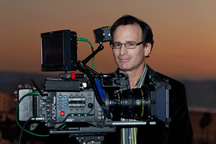Footage
Footage refers to sequences of moving images, typically captured on film or video. The term originates from the early days of the film industry, when the length of a film would be measured in feet. Today, footage is used in various contexts, including television, movies, video games, and online media. It can be shot using a wide range of devices, from professional cinema cameras to smartphones, and is a fundamental component of visual storytelling.
Types of Footage[edit | edit source]
Footage can be categorized based on its purpose, source, or format. Some common types include:
- Raw Footage: This is unedited material as it was originally recorded. It often requires post-production work, such as editing, color correction, and sound mixing, before it is ready for viewing.
- Stock Footage: These are video clips that have been shot for the purpose of being sold or licensed for use in other productions. Stock footage can be a cost-effective solution for adding high-quality visuals without the need for a custom shoot.
- Archival Footage: This refers to historical video material that has been preserved and can be used in documentaries or other projects to provide historical context or evidence.
- B-roll: B-roll footage consists of supplemental or alternative shots used to cut away from the main action. It is often used in interviews and documentaries to add visual interest and support the narrative.
Usage[edit | edit source]
Footage is used in a variety of ways across different media platforms. In the film and television industry, it is the raw material from which final productions are crafted. In advertising, footage is used to create engaging commercials and promotional videos. News organizations rely on footage to report on current events, while content creators use it to produce a wide range of online content, including vlogs, tutorials, and reviews.
Acquisition and Licensing[edit | edit source]
Acquiring footage can be done through filming, purchasing or licensing stock footage, or accessing archival footage from libraries or other sources. The choice between these options depends on the project's budget, the specificity of the needed shots, and the production timeline. Licensing agreements are crucial when using stock or archival footage to ensure compliance with copyright laws.
Technical Considerations[edit | edit source]
When working with footage, several technical aspects need to be considered, including resolution, frame rate, and format. High-definition (HD) and 4K are common resolutions that offer high-quality images. Frame rate, measured in frames per second (fps), affects how smoothly the video plays. Common frame rates include 24fps for a cinematic look and 30 or 60fps for video productions. The format of the footage (e.g., RAW, ProRes, H.264) can impact the quality and file size, as well as compatibility with editing software.
Conclusion[edit | edit source]
Footage is a versatile and essential element in the creation and dissemination of visual media. Its use spans across various industries and has evolved with technological advancements in video production and distribution. Understanding the types, uses, and technical aspects of footage is crucial for filmmakers, content creators, and media professionals.
Search WikiMD
Ad.Tired of being Overweight? Try W8MD's physician weight loss program.
Semaglutide (Ozempic / Wegovy and Tirzepatide (Mounjaro / Zepbound) available.
Advertise on WikiMD
|
WikiMD's Wellness Encyclopedia |
| Let Food Be Thy Medicine Medicine Thy Food - Hippocrates |
Translate this page: - East Asian
中文,
日本,
한국어,
South Asian
हिन्दी,
தமிழ்,
తెలుగు,
Urdu,
ಕನ್ನಡ,
Southeast Asian
Indonesian,
Vietnamese,
Thai,
မြန်မာဘာသာ,
বাংলা
European
español,
Deutsch,
français,
Greek,
português do Brasil,
polski,
română,
русский,
Nederlands,
norsk,
svenska,
suomi,
Italian
Middle Eastern & African
عربى,
Turkish,
Persian,
Hebrew,
Afrikaans,
isiZulu,
Kiswahili,
Other
Bulgarian,
Hungarian,
Czech,
Swedish,
മലയാളം,
मराठी,
ਪੰਜਾਬੀ,
ગુજરાતી,
Portuguese,
Ukrainian
Medical Disclaimer: WikiMD is not a substitute for professional medical advice. The information on WikiMD is provided as an information resource only, may be incorrect, outdated or misleading, and is not to be used or relied on for any diagnostic or treatment purposes. Please consult your health care provider before making any healthcare decisions or for guidance about a specific medical condition. WikiMD expressly disclaims responsibility, and shall have no liability, for any damages, loss, injury, or liability whatsoever suffered as a result of your reliance on the information contained in this site. By visiting this site you agree to the foregoing terms and conditions, which may from time to time be changed or supplemented by WikiMD. If you do not agree to the foregoing terms and conditions, you should not enter or use this site. See full disclaimer.
Credits:Most images are courtesy of Wikimedia commons, and templates, categories Wikipedia, licensed under CC BY SA or similar.
Contributors: Prab R. Tumpati, MD



